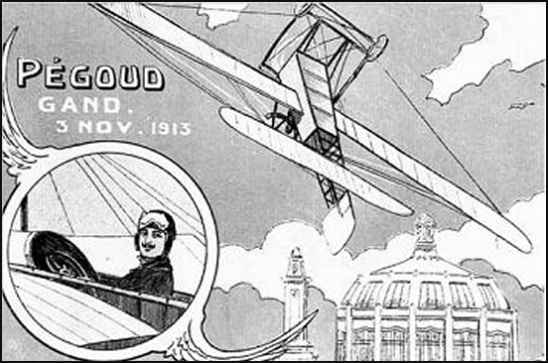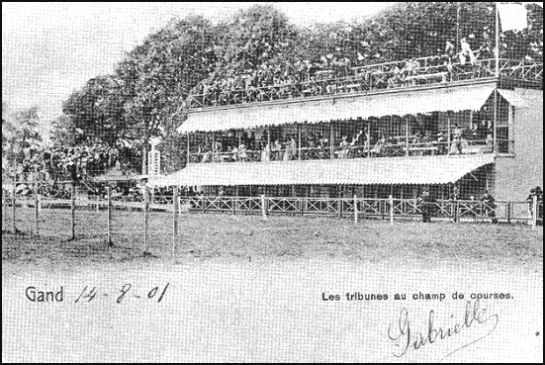
via email from Manu De Canck, 7-17-07 I’m Manu from Ghent, Belgium. I’ve got information ‘bout Pégoud. In 1913 there was a huge World Fair, (Exposition Universelle et Industrielle), organized in our hometown here in Ghent in Flanders and Pégoud came over. He was at that time already the celebrated acrobat we all know. After Paris, London and Vienna, Ghent was the fourth town he visited in a European tour. I can look for a more detailed report on that show in the old magazines I have. I guess I got a picture postcard of him during that event as well. A commemoration card, you know. If interested, let me know. Manu De Canck Gent, Belgium |
|
ADOLPHE PÉGOUD AT THE GHENT WORLD FAIR 1913 The Ghent World Fair (Gent as it is called in Flemish, is an ancient medieval town in Belgium very worthwhile visiting!) was the last to take place before the First World War. It attracted millions of people and lasted for about seven months. The mayor closing event was the coming of Adolphe Pégoud on 3 November 1913... The newspapers announced his coming on October, 31: "Adolphe Pégoud will arrive in Ghent on Monday morning. A special one seater with an engine of 50 HP is on it's way from Paris to the St.-Denis Aerodrome. It will be tuned by mechanics from the Blériot household and prepared for use." |
 |
| Above: The official postcard of the Ghent World Fair 1913 showing Pégoud's famous Loop. "Gand" is the dity's name in French, as the upper class preferred not to speak Flemish at the time. This they did to distinguish themselves from the poor working class people in the many factories. |
|
3 November: The papers: "Already from 8 o' clock in the morning there was an unusual bustle in the city. Everybody wanted to admire the aerial acrobat Pégoud. Trams were literally taken by storm. Lots of automobiles rushed about and made the streets unsafe (cars were of course not very common at the time!)." "The Ghent folks were lucky. A pleasant sun shone upon the crowd, who trooped from all sides to witness the cold-bloodedness of one man. The closer one got to the St.-Denis Field, the more difficult it got to make one's way through. There were off course those who never fail to be on such occasions: gangs of venders with a portrait of the flyer." It was extraordinary indeed! The St.-Denis Field lay about three miles from the Fair, 8-10 miles outside the centre of the city and most of the people made the walk on foot! |
 |
| Above: The St.-Denis Aerodrome ("Sint-Denijsplein" in Flemish) in 1901. It started as a hippodrome as there were still no aircrafts. But on the other hand, these tribunes were in place when Pégoud made his visit there! |
|
The papers: "A little before 11 Pégoud took off. First he flew around the field, making turns at the same time that made the spectators shiver. Everybody believed he would come crashing down any moment. After the third round one got the impression as if those stunts were actually very natural. So elegant and smooth they were performed. Then the flyer took higher. At the height of a 1000 yards he did a "saut périlleux" (a dangerous jump) who ashamed even the birds by climbing, the wheels of his plane in front of him, then turning to the side, and continuing after a drop into normal position. This he performed 8 times in a row as if it was child play, arousing the crowd who applauded with enthusiasm." "When Pégoud landed in spiral there was a yelling all over. The masses ran towards him and not even the police nor the army regulars who were there for his protection could prevent them from nearing the aircraft. The flyer looked very cheerful and certainly not terrified himself! First he was ridden around the field and then taken upon the shoulders by his friends. Everyone fought and wrestled to shake his hand or at least to get a glimpse of him." "It's really worth the cost seeing "The Birdman", as Pégoud is called, at work. His tumbles raise the hairs on everyone's skin. For more than a minute Pégoud had to do everything the other way around, flying his head down. This he performed seven times. Not to mention his "Looping the Loop" or Death Jump which already filled the Parisian public with awe." During the afternoon there was a second show and this for an even larger public. Again people were on the move all along the Kortrijksesteenweg (name of the main road to the fair): "The fog hung like a mist over the road and the smoke, the puffing and noise of the cars were at times unbearable. But young and old, everyone was there to see the marvels of the acrobat." At 15.30 Pégoud took to the air and it looked like as if he was even more into it than this morning. 15 times he flew on his back and continued his neck-breaking turns for a full three quarters of an hour. The papers next day: "Again the same cheering of the people, the triumphant carrying around, the congratulations and the rushing forward to see the hero at close quarters. Never ever has a king nor even an emperor been able to mobilize the people in such way or harvested this kind of jubilation as did Pégoud yesterday." Pégoud continued to live on in the imagination of the Ghent people. Even today, most of the 230.000 inhabitants know his name. A new part of town, with commerce, exposition possibilities, freetime opportunities is in the making and is called "Gent The Loop", after Pégouds acrobacy. It lies in the vicinity of the former St.-Denis Airfield, that shut down in 1985 to make place for a large exhibition complex called Flanders Expo. To the regrets of so many! The Airfield has a history of it's own, off course: it was used 'til the end as a flying sports club. During WW II it was once totally unexpected heavily strifed by German fighters and was also the scene of pope John Paul II's visit to Belgium. He was flown in by a Seaking helicopter from the Belgian Air Force and greeted by an immense crowd who followed mass there. But back to Pégoud! A popular folk song was made off him immediately after the World Fair in the Ghent dialect and it's still sung in bars and café's!!! The chorus is part of a local potpourri. It goes like this!!! |
|
"En Pigoe goa noar omuuge Om zaan kunste te vertuuge Iest op zaane rugge En toens op zaanen buik En zuu vliegt jaa de pieste 'n' uit!" |
(And there Pégoud gets up high) (To demonstrate his tricks) (First on his back) (And then on his belly) (And doing so he quits the circus!) |
|
Hope you like the contribution, Ralph! I did my military service as a Search and Rescue doctor on the Seaking, so,
I do LOVE PLANES!!! Manu Contact: manu.de.canck@telenet.be |


|